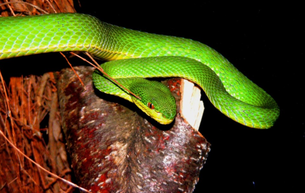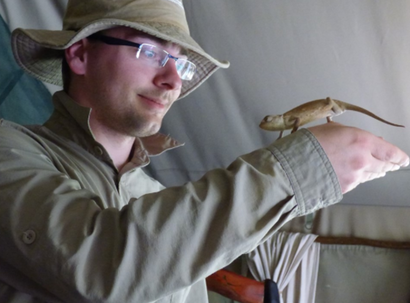Links to publications are available from my staff profile
(https://www.swansea.ac.uk/staff/science/biosciences/arbucklek/) or personal academic website (https://swansea.academia.edu/KevinArbuckle)
Journal Articles
- Baumann, K., Vicenzi, E.P., Lam, T., Douglas, J., Arbuckle, K., Cribb, B., Brady, S.G. and Fry, B.G. 2018. Harden up: metal acquisition in the weaponized ovipositors of aculeate Hymenoptera. Zoomorphology 137:389 - 406
- Derez, C.M., Arbuckle, K., Ruan, Z., Xie, B., Huang, Y., Dibben, L., Shi, Q., Vonk, F., Fry, B.G. 2018. A new species of bandy-bandy (Vermicella: Serpentes: Elapidae) from the Weipa region, Cape York, Australia. Zootaxa 4446:1 - 12
- Oulion, B., Dobson, J.S., Zdenek, C.N., Arbuckle, K., Lister, C., Coimbra, F.C.P., op den Brouw, B., Debono, J., Rogalski, A., Violette, A., Fourmy, R., Frank, N. and Fry, B.G. 2018. Factor X activating Atractaspis snake venoms and the relative coagulotoxicity neutralising efficacy of African antivenoms. Toxicology Letters 288:119 - 128
- Goldenberg, J., Cipriani, V., Jackson, T.N.W., Arbuckle, K., Debono, J., Dashevsky, D., Panagides, N., Ikonomopoulou, M.P., Koludarov, I., Li, B., Santana, R.C., Nouwens, A., Jones, A., Hay, C., Dunstan, N., Allen, L., Bush, B., Miles, J.J., Ge, L., Kwok, H.F. and Fry, B.G. 2018. Proteomic and functional variation within black snake venoms (Elapidae: Pseudechis). Comparative Biochemistry and Physiology – Part C: Toxicology & Pharmacology 205:53 - 61
- Visser, M. and Arbuckle, K. 2017. Apparent envenomation of a captive blue dart frog (Dendrobates tinctorius) by an eyelash viper (Bothriechis schlegelii) without symptoms of toxicity. Herpetological Bulletin 142:35 – 36
- Arbuckle, K., Rodríguez de la Vega, R.C. and Casewell, N.R. 2017. Coevolution takes the sting out of it: evolutionary biology and mechanisms of toxin resistance in animals. Toxicon 140:118 – 131
- Rogalski, A., Soerensen, C., op den Brouw, B. Lister, C., Dashevsky, D, Arbuckle, K., Gloria, A., Zdenek, C., Casewell, N.R., Gutiérrez, M., Wüster, W., Ali, S.A., Masci, P., Rowley, P., Frank, N. and Fry, B.G. 2017. Differential procoagulant effects of saw-scaled viper (Serpentes: Viperidae: Echis) snake venoms on human plasma and the narrow taxonomic ranges of antivenom efficacies. Toxicology Letters 280:159 - 170
- Yang, D.C., Dobson, J., Cochran, C., Dashevsky, D., Arbuckle, K., Benard, M., Boyer, L., Alagón, A., Hendrikx, I., Hodgson, W.C. and Fry, B.G. 2017. The bold and the beautiful: a neurotoxicity comparison of New World coral snakes in the Micruroides and Micrurus genera and relative neutralisation by antivenom. Neurotoxicity Research 32:487 - 495
- Lister, C., Arbuckle, K., Jackson, T.N.W., Debono, J., Zdenek, C., Dashevsky, D, Dunstan, N, Allen, L., Hay, C., Bush, B., Gillett, A. and Fry, B.G. 2017. Catch a tiger snake by its tail: differential toxicity, co-factor dependence and antivenom efficacy in a procoagulant clade of Australian venomous snakes. Comparative Biochemistry and Physiology – Part C: Toxicology & Pharmacology 202:39 - 54
- Koludarov, I., Jackson, T.N.W., Op den Brouw, B., Dobson, J., Dashevsky, D., Arbuckle, K., Clemente, C.J., Stockdale, E.J., Cochran, C., Debono, J., Stephens, C., Panagides, N., Bin, L., Manchadi, M.-L.R., Violette, A., Fourmy, R., Hendrikx, I., Nouwens, A., Clements, J., Martelli, P., Kwok, H.F. and Fry, B.G. 2017. Enter the dragon: the dynamic and multifunctional evolution of Anguimorpha lizard venoms. Toxins 9:242
- Cuthill, I., Allen, W., Arbuckle, K., Caspars, B., Chaplin, G., Hauber, M., Hill, G., Jablonski, N., Jiggins, C., Kelber, A., Mappes, J., Marshall, J., Merrill, R., Osorio, D., Prum, R., Roberts, N., Roulin, A., Rowland, H., Sherratt, T., Skelhorn, J., Speed, M., Stevens, M., Stoddard, M., Stuart-Fox, D., Talas, L., Tibbetts, E. and Caro, T. 2017. The biology of colour. Science 357:eaan0221
- Cipriani, V., Debono, J., Goldenberg, J., Jackson, T.N.W., Arbuckle, K., Dobson, J., Koludarov, I., Li, B., Hay, C., Dunstan, N., Allen, L., Hendrikx, I, Kwok, H.F. and Fry, B.G. 2017. Correlation between ontogenetic dietary shifts and venom variation in Australian brown snakes (Pseudonaja). Comparative Biochemistry and Physiology – Part C: Toxicology & Pharmacology 197:53 - 60
- Speed, M.P. and Arbuckle, K. 2017. Quantification provides a conceptual basis for convergent evolution. Biological Reviews 92:815 - 829
- Panagides, N.*, Jackson, T.N.W.*, Pretzler, R.*, Ikonomopoulou, M.P.*, Arbuckle, K.*, Yang, D.C., Ali, S.A., Koludarov, I., Dobson, J., Sanker, B., Asselin, A., Santana, R.C., Hendrikx, I., van der Ploeg, H., Tai-A-Pin, J., van den Bergh, R., Kerkkamp, H.M.I., Vonk, F.J., Naude, A., Strydom, M., Jacobsz, L., Dunstan, N., Jaeger, M., Hodgson, W.C., Miles, J., Fry, B.G. 2017. How the cobra got its flesh-eating venom: cytotoxicity as a defensive innovation and its co-evolution with hooding, aposematic marking, and spitting. Toxins 9:103 *Joint first authors
- Arbuckle, K. 2017. Book review: Understanding Evolution (Kostas Kampourakis). ISBE Newsletter 29:14 - 16
- Arbuckle, K. 2016. Chemical antipredator defence is linked to higher extinction risk. Royal Society Open Science 3:160681
- Harris, R.J. and Arbuckle, K. 2016. Tempo and mode of the evolution of venom and poison in tetrapods. Toxins 8:193
- Arbuckle, K. 2016. Look on the bright side for (evolutionary) radiation [published conference abstract]. Perception 45:356 - 357
- Nichols, H.J., Zecherle, L. and Arbuckle, K. 2016. The evolution of post-reproductive lifespan in mammals. Biology Letters 12:20150992
- Arbuckle, K. and Speed, M.P. 2015. Antipredator defences predict diversification rates. PNAS 112:13597 - 13602
- Ujvari, B., Casewell, N.R., Sunagar, K., Arbuckle, K., Wüster, W., Lo, N., O'Meally, D., Beckmann, C., King, G.F., Deplazes, E. and Madsen, T. 2015. Widespread convergence in toxin resistance by predictable molecular evolution. PNAS 112:11911 - 11916
- Arbuckle, K. and Minter A. 2015. windex: Analysing convergent evolution using the Wheatsheaf index in R. Evolutionary Bioinformatics 15:11 - 14
- Slight, D.J., Nichols, H.J. and Arbuckle, K. 2015. Are mixed diets beneficial for the welfare of captive axolotls (Ambystoma mexicanum)? Effects of feeding regimes on growth and behaviour. Journal of Veterinary Behavior: Clinical Applications and Research 10:185 - 190
- Arbuckle, K., Bennett, C.M. and Speed, M.P. 2014. A simple measure of the strength of convergent evolution. Methods in Ecology and Evolution 5:685 - 693
- Arbuckle, K., Brockhurst, M. and Speed, M.P. 2013. Does chemical defence increase niche space? A phylogenetic comparative analysis of the Musteloidea. Evolutionary Ecology 27:863 - 881
- Arbuckle, K. 2013. Folklore husbandry and a philosophical model for the design of captive management regimes. Herpetological Review 44:448 - 452
- Arbuckle, K. 2012. Vipera berus: Defensive behaviour. Herpetological Review 43:499
- Arbuckle, K. 2010. Suitability of day-old chicks as food for captive snakes. Journal of Animal Physiology and Animal Nutrition 94:e296 – e307
- Arbuckle, K. 2009. Ecological function of venom in Varanus, with a compilation of dietary records from the literature. Biawak 3:46 – 56
- Arbuckle, K. 2008. Plestiodon fasciatus: Escape behaviour. Herpetological Review 39:91 – 92
Book Chapters
- Arbuckle, K. 2017. Evolutionary context of venom in animals; in Malhotra, A. and Gopalakrishnakone, P. (eds) Evolution of Venomous Animals and Their Toxins (Springer Handbook of Toxicology series). Springer, Netherlands
- Arbuckle, K. and Speed, M.P. 2016. Analysing convergent evolution: a practical guide to methods; in Pontarotti, P. (ed) Evolutionary Biology: Convergent Evolution, Evolution of Complex Traits, Concepts and Methods. Springer, Netherlands



Social Media
@phylophile